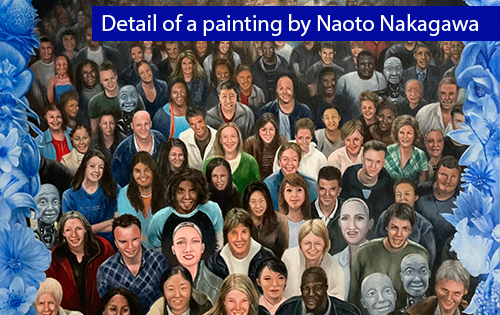
A GROUP OF ARTISTS ARE THINKING ABOUT ART’S CATHARTIC POWER, ART’S RELATIONSHIP TO HISTORY AND MEMORY, AND HOW THEY’LL ORGANIZE THEIR FINISHED WORKS AND PRESERVE THEIR LEGACIES
Here’s a fourth selection of “On my mind” comments and observations from a variety of creative sources.
LAURA FACEY
Based in the hills in the northern part of the Caribbean island of Jamaica, the artist Laura Facey (Instagram: @laurafacey_) is known for making large-scale sculptures using indigenous woods. Employing the language of abstraction, with strong references to history and nature, Facey’s works tend to exude an air of eloquence and spirituality.
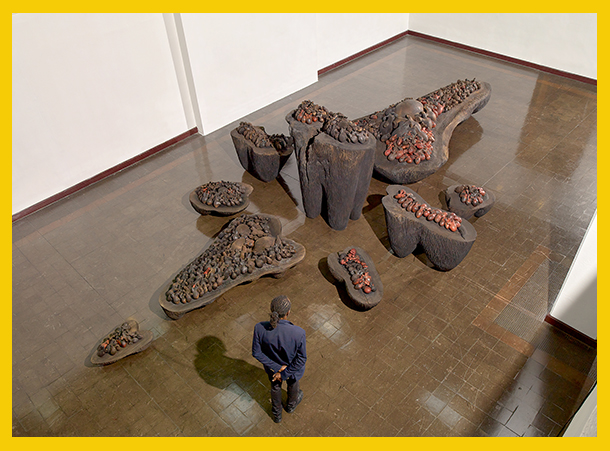
One of her recent sculptural works, “Guide Their Way Home,” is on Facey’s mind these days as she continues developing the ideas and research that informed it, and as she looks for opportunities to exhibit it. About this large work, she told us, “‘Guide Their Way Home’ was shown at my Laboratory of the Ticking Heart exhibition last year; it took place in downtown Kingston [Jamaica’s capital], at Ormsby Memorial Hall, where Bob Marley once performed. It’s a challenging work that may trigger troubling emotions. It acknowledges Jamaica’s story [which includes the long period of slavery during the colonial era], difficulty, and precarity.”
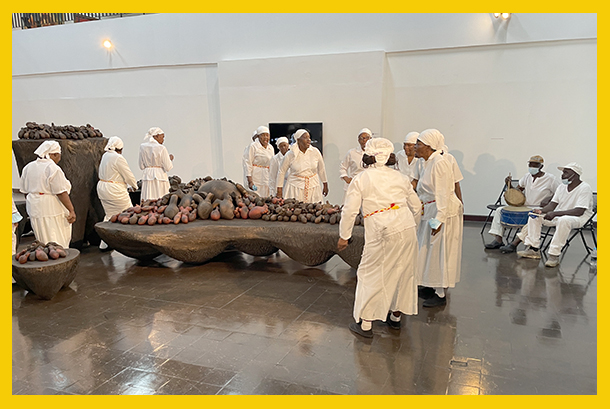
The hearts that are visible in “Guide Their Way Home” allude, Facey suggested, to a combined sense of “upheaval, wrenching loss, and unmitigated cruelty.” She added, “This work assists us in the ongoing recognition that most Jamaicans have experienced terror and abuse, including down the genetic timeline and, as a result, that many carry feelings that have become locked or buried within.”
“Suppressed, hidden, and burdensome, they’re too many to carry. The price for not addressing these issues is highlighted in the current struggles facing humanity. A reconciliation process, which brings consciousness to the unconscious, is imperative.”
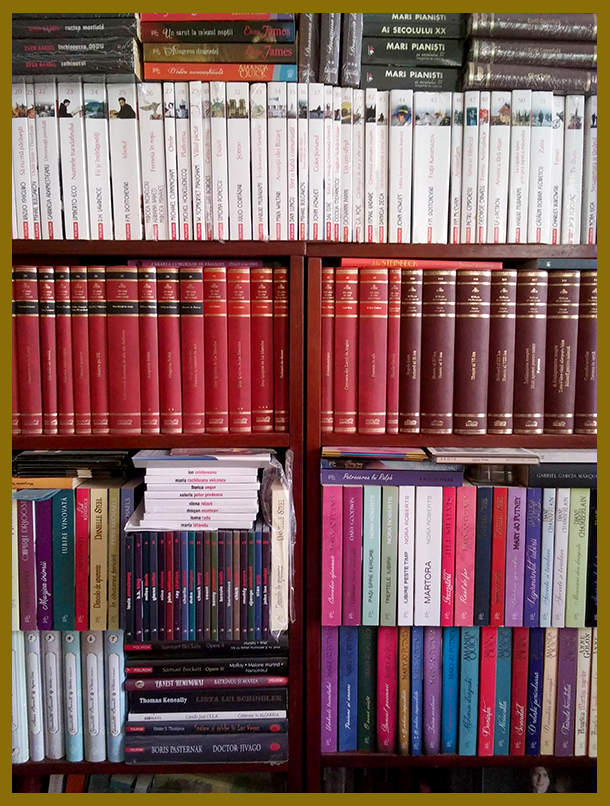
ELLA VERES
The Romanian-born, New York-based artist, writer, and performer Ella Veres (Instagram: @vermilion.nyc) offers another, separate “On my mind” comment that can be found in the first part of this month’s special section, along with a note introducing her. Here, she shares a second dispatch, which is also related to her recent trip to Europe, which included a stop in her native Romania, a country she had not visited in many years.
Providing some context for her second comment, Veres told us, “During the long period of communism in Romania, books were not available. Now they are.”
In her second “On my mind” item, she writes:
“Our possessions are choking our space. We’re buried in things we acquire for the experiences encapsulated in them, yet we just amass them, like deranged squirrels gathering acorns without eating them, filling their dens with acorns, and dying under avalanches of nuts.”
“Back in Romania, my sister boasts about owning 4000 unopened books, many of which are still in their plastic shrink wrap. This hell is a private one, causing alarm to its owner if you gaze at it disapprovingly.”
“Books transport me. The paths of words that flower up in an author’s world — as a reader, you walk in his or her word footprints, conversing.”
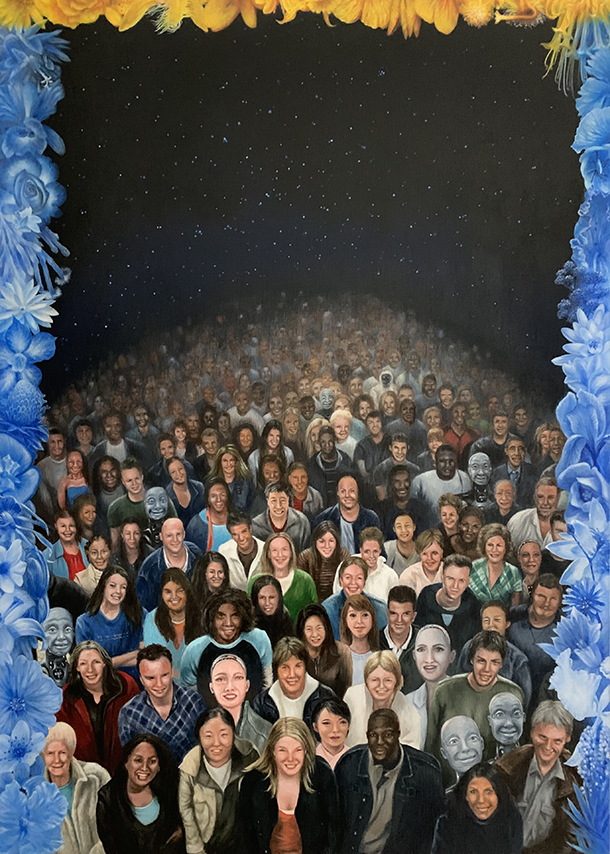
NAOTO NAKAGAWA
The Japanese-born artist Naoto Nakagawa has lived and worked in New York since the 1960s. Known for complex compositions and a skillful, realist painting technique, decades ago he produced a series of hyperrealist still lifes. He has painted large-scale canvases featuring thickets of tress and created ink-on-paper portraits of 1000 people whose lives were affected by the earthquake and tsunami that struck Japan’s Tohoku region in March 2011.
Several years ago, Nakagawa produced “Stars of the Forest,” a large painting that serves as a memorial to the people who lost their lives in the terrorist attacks that took place on American soil on September 11, 2001. It’s now in the permanent collection and on view at the 9/11 Memorial & Museum in New York.
Nakagawa’s contribution to “On my mind” includes a brief statement and one of his recent paintings (above), to which it refers.
Nakagawa writes: “In the difficult times we live in now, when we may be marching toward the extinction of this beautiful planet Earth, my thoughts are with all the people of the world.”
“Here is a painting I made in 2022, titled ‘People of the World.” There are quite a few AI robots included in this composition. I put myself in it, too.”
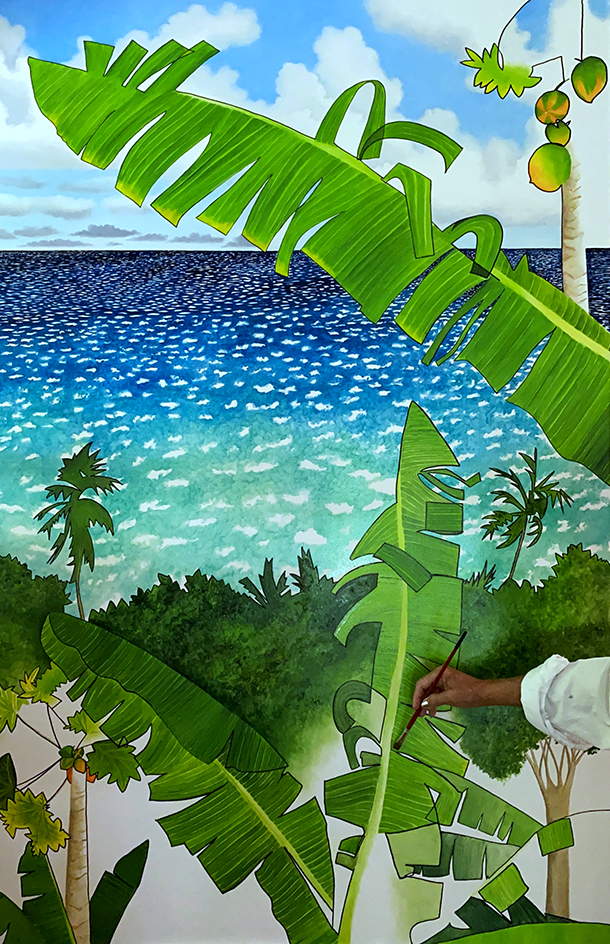
LISA REMENY
The painter Lisa Remeny (Instagram: @lisaremeny) was born and grew up in Miami. Today, she lives in nearby Coconut Grove. She first studied art with her maternal grandmother, who taught her how to use watercolors. Her mother, who made oil paintings, taught Lisa how to use oil paints. Later, in the Bay Area, she studied at the California College of Arts and Crafts (later the California College of the Arts), where she focused on drawing, printmaking, photography, and filmmaking.
Remeny’s art expresses her deep and abiding interest in — and concern about — nature. She writes:
“On my mind right now, as ever, is my former home on the north coast of Jamaica, where I lived many years ago and enjoyed my first adult experiences of pure, unadulterated beauty. They have continued to inspire me for 40-plus years.”
“Now that the world is heating up, and some people are more apathetic than ever about the state of our natural resources, I wonder if my old stomping grounds are still blessed with cool sea breezes, even in the summer. I thrived for years, without any air conditioning, in the locale that is pictured here in my latest work (above). We were always comfortable. Is this still the case in that unforgettable corner of the universe?”
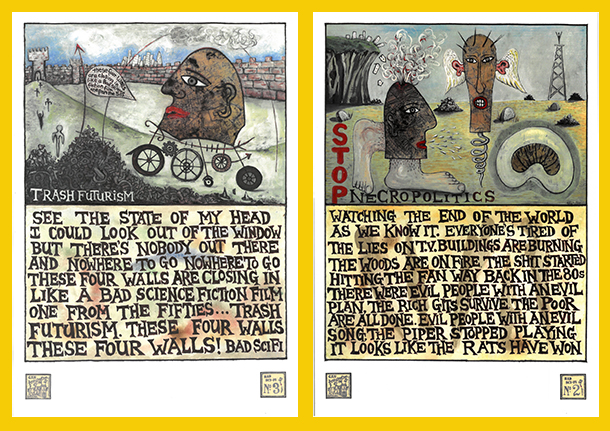
STEVEN FORSTER
Steven Forster is a British artist and musician who lives in Catalunya (Catalonia), in northeastern Spain, and often presents his work and performs in concerts in Barcelona. Forster makes art in various genres and media, including installations that he sets up outdoors in the branches of trees.
His “On my mind” comment consists of some lyrics excerpted from his song “These Four Walls, Part 1,” an illustration of which he also produced (above). Forster’s lyrics say:
“Take a look at the stars
There are millions and billions
And there´s space in-between them,
Well, that´s how it seems
Or is it just a dream?”
[…]
“Now take a look at this world
Sliding swiftly to somewhere
Where all human is worthless
And nothing is sacred
Well, that´s how it seems I hope it´s just a dream.”
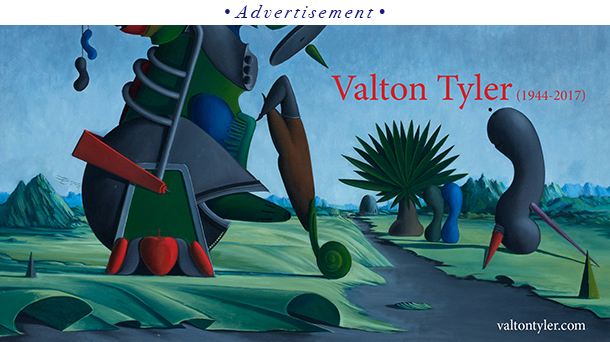
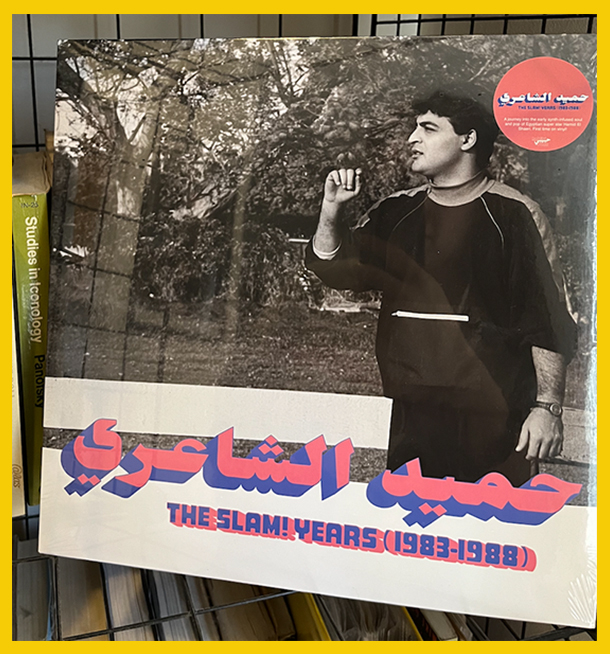
SARAH FENSOM
The Los Angeles-based arts writer Sarah Fensom, who serves as brutjournal’s U.S.A. West Coast bureau chief, is constantly surveying the cultural landscape for emerging trends and interesting finds. On her mind now is one of her recent musical discoveries. She writes:
“What’s on my mind is The SLAM! Years: 1983-1988, a compilation album featuring early tracks by the Libyan-Egyptian musical artist Hamid Al Shaeri. The German label Habibi Funk released the album in 2022, but I only discovered it on Spotify about three weeks ago. I’ve been listening to it everywhere — on hikes in Griffith Park, in Koreatown traffic on my way to pick up Pakistani food, and while lying down writing and sweating in a cashmere tank top, with my back sticking to the leather couch in the late-September heat.”
“Born in 1961, Shaeri is regarded as a pioneer of Al Jeel, a pop genre that emerged in Egypt in the 1970s and 1980s. The songs on this album were originally released by the popular Egyptian record label SLAM! before Shaeri gained wide acclaim; they blend shimmering, upbeat synth pop with funk, rock ’n’ roll, traditional Arabic music, and even, dare I say, ragtime on ‘Oyoun Houriyat.’ Shaeri’s voice is angelic and soft. It reminds me of the velvety, peach-toned tissues my grandmother kept in her upstairs bathroom to blot her lipstick. Listen to Shaeri’s ‘Ayonha,’ the sonic equivalent of finely milled powder and crushed violets, and you’ll understand what I mean.”

LAURA McMANUS
Laura MaManus is a painter who, along with her husband, the artist Jim McManus, owns and operates The Camptons, a gallery in the riverside town of Hancock, in upstate New York, on the border with Pennsylvania. With their bold linework and restrained but vibrant palettes, Laura’s paintings take aspects of the landscape as their subjects, which the artist analyzes and depicts in an energetic, stylized manner.
Laura McManus writes:
“What’s on my mind? The weight of the world. I feel that there is so much coming at us each day. For me and so many others, it’s sometimes difficult to process it all in any rational way. At the same time, just like our friends and families and humanity as a whole, we’re dealing with life’s daily trials. The world feels heavy when you look at it on a wider scale and consider climate change, war, and people moving from one place to another in large numbers. My awareness of all of this definitely enters my art.”
“Against this backdrop, the act of making art feels like a release — a way for the brain to try to make sense of things, even as it may not be so easy to articulate any sense of understanding in words.”
McManus says she finds that making art provides “a way of maintaining some sort of optimism and a way to keep moving forward as everything continues changing so quickly, and trying to work out solutions to the problems we’re facing feels like too much for the brain to handle! I’m grateful for artists and friends who keep bringing ideas to the fore and carrying on with their work, which seems to have become more important now than ever.”
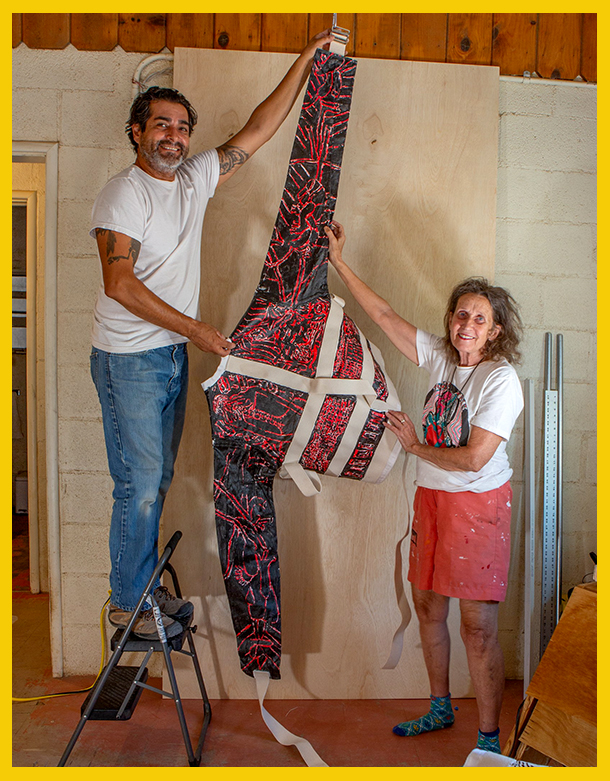
LINDA SIBIO
Based in Joshua Tree, in southeastern California, the artist Linda Sibio works in a variety of media and also creates and appears in her original perfrmance-art pieces. On her mind lately has been the development of one of her new performance-based works. She writes:
“My mind has been exposed in my new piece, ‘Economics of Suffering, Part IV,’ whose premiere took place on September 30 at the Craft Contemporary Museum in Los Angeles. Clearly, fragments of my mind have been exposed like electrical wires across the desert landscape. For four years, I’ve focused on the unthinkable, clarifying my thoughts, which come to me in short fragments — in opposites or dismembered or in chaos. I’ve finally successfully taken images from my psychotic mind and put them in a room that lets them breathe within a structure I’ve created.”
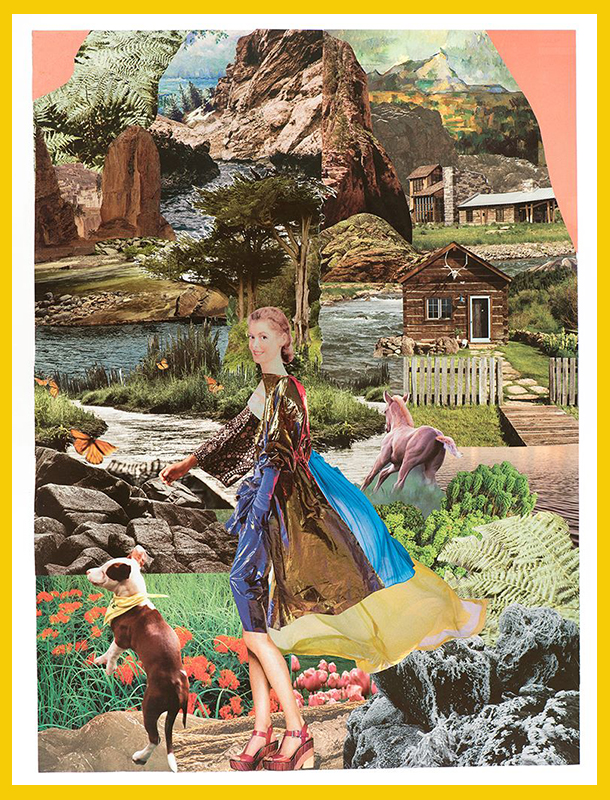
STEVEN RUDIN
Based in New York, Steven Rudin (Instagram: @stevenrudinart) is a practicing psychiatrist, teacher, and creator of sophisticated collage works whose compositions are packed with lively, puzzling juxtapositions of subject matter. These works bring to mind the spirit of the iconic collages of the British artist Richard Hamilton (1922-2011), whose work became associated with the Pop Art movement in England in the 1960s. Rudin sometimes leads workshops focusing n the art of collage. In his “On my mind” missive, he writes:
“I’ve been thinking a lot about art as a rehearsal that prepares us to take on challenges outside the studio. In addition to serving as a powerful way to process complex feelings and ideas, art provides an avenue to practice new ways of thinking and doing. At each step along the way, the creative process teaches us that problem-solving is not linear. Its zigzags, tangents, and full circles demonstrate that solutions can often pop up unexpectedly. Appreciating that the act of creating is much more than the product really resonates.”

DAVID O’FLYNN
In London, David O’Flynn is the director of The Adamson Collection (Instagram: @adamsoncollection), an international repository of art objects made by people who lived in European mental asylums. As its website notes, the collection’s holdings include some 5500 objects — paintings, drawings, ceramics, sculptures, and works on stone, flint and bone — that were created between 1946 and 1981 by residents of the Netherne, a British, long-stay mental hospital. The Adamson Collection’s website notes that all of this material is “important in the histories of British asylums and postwar psychiatry, of art therapy and Jungians and of outsider art. It was encouraged and collected by an artist, Edward Adamson, rather than [by] a psychiatrist, and strongly represents the work of women.”
On O’Flynn’s mind, he informed us, is an incident that took place several years ago at Bethlem Royal Hospital, a famous psychiatric facility in south London. In his note, he wrote:
“A mother, now activist, Aji. The Prada shoes of her son, Seni, who was killed by police in September 2010, under prolonged restraint on a Bethlem Royal Hospital ward, 300 meters from Bethlem Gallery [a venue on the hospital grounds that exhibits work by non-mainstream, mostly self-taught art-makers].”
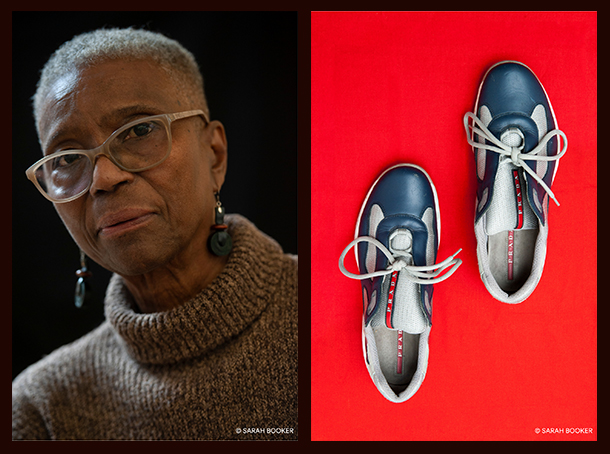
“In June 2020, an unknown graffiti artist added ‘R.I.P. SENI’ across a public artwork that was on display outside the Bethlem Gallery. As the chair of the gallery at the time, I was involved that first morning [when the defaced artwork was discovered]. Now, after decades as a psychiatrist, I work with Aji. From these relentlessly repeating, state-sanctioned killings of those in mental-health crisis, out of this violence driven by racism and othering, emerges raw art that is enraged, urgent, and political.”
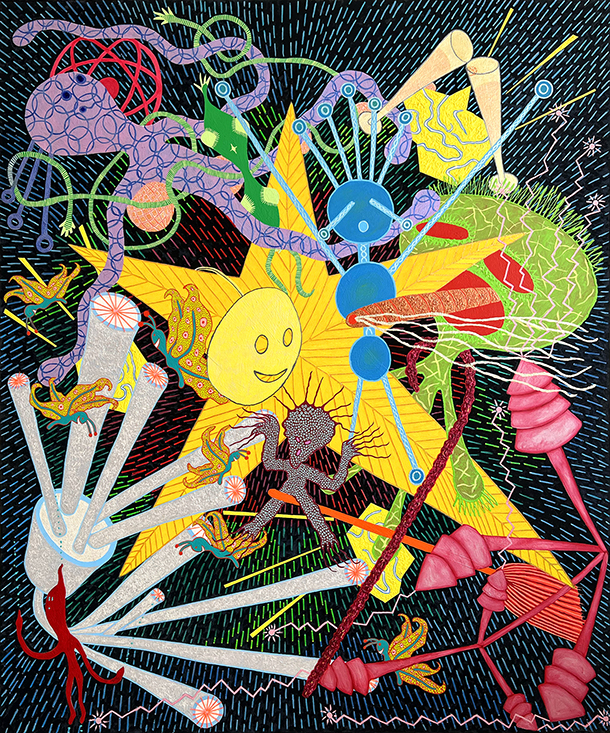
GIGI SPRATLEY AND JACK WALTRIP
Like many artists who have worked for many years and built up a significant body of work, the New York-based makers of visual art and music, Gigi Spratley (Instagram: @gigispratley) and Jack Waltrip, who work collaboratively, have been going back through and organizing their archive. On their minds is how to summarize and describe their interests and accomplishments over several decades. Their “On our minds” comment comes from a text they’ve been working on to introduce themselves and their creative work. It says:
“We have been collaborating on art, music, animation, and writing for two decades. We work together on many levels. Our work addresses the cycles of life, the rotation of the earth, the passage of time, and the inevitability of change. We attempt to accentuate the beauty of organic forms. Our 3-D work is conceived as a space between dreams and meditation, where veiled potential can be revealed, just as 3-D glasses reveal an alternative experience for the viewer. Our projects have evolved into street art, writing, and animation projects.”


